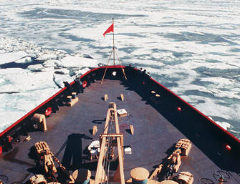
[Editor's note: Stephen Harper stood ground against the U.S in his first news conference as prime minister-elect. At issue: Harper's vow to deploy military icebreakers to monitor and defend our northern arctic waters. The day before, U.S. ambassador to Canada David Wilkins had opposed the plan, stating, "There's no reason to create a problem that doesn't exist." Harper's response on Friday: "The United States defends its sovereignty and the Canadian government will defend our sovereignty. It is the Canadian people we get our mandate from, not the ambassador of the United States."
At stake is control over the long sought Northwest Passage route over Canada's northern reaches, fast becoming a reality thanks to global warming. To understand the significance of such a passage, and Canada's interests there, the Tyee presents this in-depth article by UBC international law expert Michael Byers. The text below is adapted from a speech he gave to The Vancouver Institute on January 28.]
To the north of the Canadian mainland lies a vast, polar archipelago made up of 19,000 islands and countless rocks and reefs. Baffin Island is larger than the British Isles, while two of the other islands, Ellesmere and Victoria, are nearly as large. For most of the year, the straits and channels between the islands are covered by sea-ice, fusing the archipelago into a triangular mass that is 3000 kilometres-wide at its base and stretches to within 900 kilometres of the geographic North Pole.
Pierre Berton called the Northwest Passage the "Arctic Grail". From Martin Frobisher in 1576, to John Franklin in 1845, generations of explorers battled the elements searching for a navigable route through the Arctic islands to Asia. Many of them--including Franklin and his men--perished in the effort. Their greatest challenge was sea-ice. Even in summer, thick, hard, multi-year ice has long choked the straits and channels, especially in the western Arctic, rendering them impenetrable to all but the most patient of explorers or, more recently, the most powerful of icebreakers. The Norwegian explorer Roald Admundsen completed the first transit in 1906, but it took him three years.
Now, however, the ice is melting. In the last three decades, climate change has caused a 25 percent decline in the area covered by Arctic sea-ice-a decline of about 2,000,000 square kilometers. The ice is also, on average, 32 percent thinner than before. The melt is particularly advanced in the western Arctic, where the edge of the multiyear ice pack has retreated north and now lies at the northern limit of the McClure Strait. Once this edge retreats beyond the entrance to the McClure Strait, we can expect a dramatic reduction in the amount of multiyear ice moving into the Northwest Passage. This development may explain why, five years ago, a report prepared for the U.S. Navy predicted that, "within 5-10 years, the Northwest Passage will be open to non-ice-strengthened vessels for at least one month each summer."
Reasons for alarm
The changing ice conditions offer a sea route between Europe and Asia that is 7,000 kilometres shorter than the route through the Panama Canal. The Northwest Passage could also accommodate supertankers and container ships that are too large for the canal. International shipping companies are eyeing the fuel, time and canal-passage fees that could be saved; some are already building ice-strengthened vessels.
The cruise ship industry is also looking north; the Kapitan Khlebnikovi, a Russian-flagged converted ice-breaker, already offers luxury voyages through the Northwest Passage-at US $10,000 per person. The melting ice will facilitate access to Alaskan and northern Canada's vast stocks of oil, gas, diamonds and precious metals.
Also, Canada's Arctic waters could eventually become a valuable fishery as reduced ice cover and warmer waters enable plankton and fish species from more temperate latitudes to move north. Indeed, Pacific salmon and Atlantic cod are already invading Arctic waters, with likely dire consequences for smaller, slower-growing indigenous species.
Canadians should be alarmed. An international shipping route along Canada's third coast could facilitate the entry of drugs, guns, illegal immigrants and perhaps even terrorists into this country, as well as providing an alternative route for illicit shipments of weapons of mass destruction or missile components by rogue states. And any shipping involves the risk of accidents, particularly in remote and icy waters. An oil spill would cause catastrophic damage to fragile Arctic ecosystems; a cruise ship in distress would require an expensive and possibly dangerous rescue mission. Any new fishery will be highly susceptible to over-exploitation, particularly because of the difficult-to-police location, rapid declines in fish stocks elsewhere and the consequent, excess fishing capacity that now exists worldwide.
Ideally, these challenges would be addressed by applying the full range of Canada's own environmental, immigration, customs and criminal laws. Sovereignty over the Northwest Passage is about much more than nationalism; it is about protecting people and the environment from serious potential harm. Yet, Canadians could soon lose any ability to regulate foreign vessels in the passage, since any foreign ship that passes through without our permission undermines the sovereignty claim.
Who owns the passage?
Ownership of the islands is not at issue. In 1880, Britain assigned them to Canada and that title has not subsequently been contested-with one small exception: Hans Island. Denmark and Canada have agreed to negotiate a solution, which will likely come in the form of a joint management regime under which the sovereignty issue will cease to matter.
In contrast, the history of Canada's claim over the Northwest Passage is fraught with confusion and indecision. Initially, it did not seem that title over the waterway mattered much, because of the nearly impenetrable ice. Still, a claim to the water was at least implicit in an assertion, first made in the late 19th century, that Canada owned everything between the 60th and 141st meridians of longitude all the way to the North Pole. The most famous articulation of this "sector theory" was made by Senator Pascal Poirier in 1907, and, two years later, Captain J.E. Bernier of the C.S. Arctic placed a plaque on Melville Island that still reads:
- This Memorial is erected today to commemorate the taking possession for the DOMINION OF CANADA of the whole ARCTIC ARCHIPELAGO lying to the north of America from long. 60°W to 141°W up to latitude 90°N.
However, apart from the Soviet Union, which attempted a similar claim, other countries did not accept the sector theory.
In 1969, an American oil company sent an ice-strengthen oil tanker, the SS Manhattan, on a test-voyage through the Northwest Passage. The company, which was cooperating closely with the U.S. government, made a point of not seeking permission from Canada. Ottawa insisted on granting permission nevertheless, and even sent an icebreaker to assist, and subsequently argued that granting the unsolicited permission prevented the voyage from undermining Canada's claim. A more convincing defence of sovereignty came from an unexpected source. As the SS Manhattan ploughed through the ice near Resolute Bay, two Inuit hunters drove their dogsleds into its path. The vessel ground to a halt, until the hunters-having made their point-moved aside.
The following year, parliament adopted the Arctic Waters Pollution Prevention Act, imposing safety and environmental requirements on all shipping within 100 nautical miles of the Arctic coast. The claimed right to pollution prevention jurisdiction was, at that time, contrary to international law, which did not recognize coastal state rights beyond the territorial sea. However, it was subsequently made legal by the 1982 United Nations Convention on the Law of the Sea, which allows coastal states to pass laws against maritime pollution out to 200 nautical miles when almost year-round ice creates exceptional navigational hazards.
Also in 1970, a second piece of legislation extended Canada's territorial sea from three to 12 nautical miles. This move was less controversial, since 60 other countries had made similar claims. Its immediate relevance lay in the fact that the Northwest Passage, at its narrowest points, is less than 24 nautical miles across. According to the Canadian government, the overlapping territorial seas meant that foreign vessels making the passage could be subject to the full range of its domestic laws. At the same time, Canada began arguing that the straits and channels between the islands were "historic internal waters".
An 'international strait'?
The latter argument rested on the fact that most of the archipelago had been mapped by British explorers prior to the transfer of title, and very few non-consensual transits had occurred. Canada also pointed out that the Inuit-who are Canadian citizens-had travelled and lived on the ice for millennia.
There was, however, some contradiction in using both the territorial sea and historic internal waters arguments, since internal waters are by definition not territorial sea. The confusion gave strength to the U.S. position, which holds that the Northwest Passage is an "international strait". International straits are narrower in breadth than territorial seas but, because they join two expanses of high seas and are used for international navigation, they are open with relatively few restrictions to ships from any country.
More than commercial shipping was at issue. During the Cold War, the United States was concerned to maintain open access for its navy, and especially its submarines, and not just through the Northwest Passage, but through straits worldwide. Under the law of the sea, submarines may pass through an international strait without surfacing or otherwise alerting the adjacent coastal state or states, something not permitted in territorial or internal waters.
In 1985, the U.S. Coastguard icebreaker Polar Sea sailed through the Northwest Passage, again without seeking permission. Ottawa, once again, made a point of granting permission; it even asked to place several "observers" on board. Washington acceded to the request, strengthening Canada's argument that the transit was consensual and even promised to provide advance notice of any future transits by its Coastguard vessels. Yet it still made a point of publicly disputing the sovereignty claim. Following the voyage of the Polar Sea, Canada again modified its legal position. Central to the new position was the drawing of "straight baselines" linking the outer headlands of the archipelago.
As the result of a 1951 decision by the International Court of Justice in a dispute between Britain and Norway, straight baselines had become a legally accepted means for determining the extent of coastal state control along fragmented coastlines, or "coastal archipelagos". Canada invoked its prior argument of historic internal waters in support of its new baselines, arguing that its title to the waters within the baselines-which by definition are internal waters-was consolidated by historic usage. The historic usage argument was reinforced in 1993 by the Nunavut Land Claims Agreement, whereby the Canadian government and Inuit affirmed that "Canada's sovereignty over the waters of the Arctic archipelago is supported by Inuit use and occupancy".
The historic consolidation argument is also supported by judgments of international courts. In 1975, in a dispute between Spain and Morocco over the Western Sahara, the International Court of Justice held that the historic presence of nomadic peoples can help to establish sovereignty. And in 1933, in a dispute between Norway and Denmark over Eastern Greenland, the predecessor to the International Court of Justice, the Permanent Court of International Justice, held that the degree of presence necessary to establish title over territory is lower in inhospitable regions than in more temperate climes.
However, the crux of the dispute centres on the requirement that international straits "are used for international navigation". Canada argues that a couple of non-consensual transits through the Northwest Passage do not provide a sufficient basis on which to consider those waters an international strait.
Canada's guard is down
The United States, in contrast, focuses on the geographic criterion-joining two expanses of high seas-and points to a 1949 judgment of the International Court of Justice, in a dispute over the Corfu Channel, which held that the volume of traffic was of no relevance. In any event, the fact that any further usage for international navigation might contribute to the Northwest Passage becoming an international strait makes it critically important that no further non-consensual transits occur.
Canada is poorly equipped to prevent such transits. Despite having the world's longest coastline, much of it ice-covered most of the time, we do not have any all-season polar icebreakers. Four of our Coastguard icebreakers do spend each summer in the Arctic, helping ships and barges loaded with supplies to reach remote communities and cargo ships and bulk carriers to access the Port of Churchill in Hudson Bay. But these vessels are neither powerful enough nor sufficiently ice-strengthened to deal with the Arctic winter and they are redeployed to the Gulf of St. Lawrence each autumn.
In 1985, Brian Mulroney's Progressive Conservative government announced that it would build a powerful all-season icebreaker, only to cancel the contract four years later. The situation is all the more worrisome because even non-Arctic countries such as China, Britain, South Africa and South Korea now own or are building vessels of this kind.
Canada does have a fleet of aged Aurora patrol aircraft which are now used mostly for fisheries protection on the east and west coasts; only one or two flights per year are devoted to "sovereignty assertion". The Canadian Airborne Regiment was able to deploy 500 paratroopers rapidly anywhere in the Arctic until the Chrétien government disbanded it in 1995. Today, our Arctic presence is made up largely of the Canadian Rangers, 1600 part-time volunteers who live in 58 hamlets stretching from Baffin Island to the Alaska frontier. The rangers know the land and ice and provide a useful-if slow-moving-search and rescue capacity, yet their abilities are dwarfed by the expanse in which they operate. They are also not equipped or trained for forcibly boarding ocean-going vessels.
Consequently, the Arctic Waters Pollution Prevention Act cannot, in practice, be applied-though, to be fair, most vessels entering the Canadian Arctic do meet its standards. It is also unclear whether the right, held by coastal states to exercise pollution prevention jurisdiction in ice-covered waters, extends to international straits, and whether that right will continue after the ice disappears.
Who needs permission?
In any event, as the ice melts, more foreign vessels could attempt to use the Northwest Passage without seeking permission-as they might do in order to evade Canada's environmental laws. Canada's legal argument could soon collapse under the weight of a few precedents, leaving us with little basis on which to regulate foreign vessels, even if we acquired enforcement capabilities in the future. In short, time is running out: we either get serious about sovereignty and protecting the environment in the Northwest Passage now, or we will lose the right to do so.
Submarine transits-which are not dependent on channels free of ice-pose a particular problem. It is widely known, though infrequently acknowledged, that submarines from several countries often travel through the archipelago under the ice. In 1985, after the Polar Sea incident, the Mulroney government announced that it would acquire 12 nuclear-powered submarines for sovereignty assertion purposes. Pressure from the United States quickly resulted in the abandonment of this plan. Almost two decades later, Canada acquired four second-hand, diesel-electric submarines from the Royal Navy that are unable to travel completely submerged for more than a few hours, rendering them useless under the ice.
Arguably, it works in Canada's favour that submarines transiting the passage do not announce their presence. Some evidence of a sense of legal entitlement is generally considered essential before a country's actions can contribute to creating a right under international law. At the same time, it seems likely that Canada, as a long-standing U.S. ally, has always known about the submarine voyages and has simply kept quiet. It is even possible that the U.S. Navy, with Canada's knowledge and perhaps covert approval, has installed underwater acoustic sensors at the chokepoints into the archipelago, though no one will publicly confirm this.
In November 2004, then-Prime Minister Paul Martin declared that sovereignty "is an issue which is becoming even more important, given climate change and the opening of the Northwest Passage to transportation, and the environmental problems that may flow from that." Under the Liberal governments of Martin and Jean Chrétien, some initial steps were taken. Auroras are being upgraded with infra-red sensors and unmanned aerial vehicles are being acquired to provide long-range surveillance at lower cost. Radarsat-2, a federally funded remote sensing satellite, will soon be able to provide up-to-date, high resolution imaging on demand-giving Canada the ability to track surface vessels from space. Yet more needs to be done.
How big a fleet?
Enforcing sovereignty over the small number of navigable straits or channels in the Canadian Arctic would not require an armada. During the recent federal election campaign, Stephen Harper promised three polar icebreakers, a deep-water port near Iqualuit, underwater sensors and a new Arctic-trained airborne battalion. If Harper fulfills his promises, Canada's claim to sovereignty over the Northwest Passage will be more robust. And there is now reason to believe that he might actually keep these promises: last Thursday, just three days after the election, Harper went out of his way to reaffirm that he had "significant plans … for defence of our sovereignty, including Arctic sovereignty."
Other less dramatic measures could also be taken. Canada currently offers a registration service to all ships entering its northern waters, but it is voluntary, unlike the corresponding services on the east and west coasts. Most ships register in order to facilitate rescues, but anyone intent on challenging or evading Canadian laws will likely not do so. Making registration in the Arctic mandatory would bolster Canada's sovereignty. And it could be done even before parliament reconvenes, with a simple Order in Council. Similarly, a couple of Canadian Forces helicopters could, along with a few commandos trained in maritime interdiction, be despatched to Resolute Bay in summer to ensure compliance.
In addition, the Department of National Defence is currently deliberating whether to install high-frequency surface-wave radar at the entrances to the passage. The time for deliberation is over. The information obtained would be useful to the Canadian Forces and Coastguard and the presence of the installations would strengthen Canada's legal position.
The terrorism factor
Most importantly, it is time to persuade Washington to change its outdated position. The United States is more concerned about terrorists finding a backdoor to North America, or rogue states using the oceans to transport weapons of mass destruction, than it is concerned about Russian submarines.
In the Arctic, these new threats could just as easily be handled by a strengthened Canadian Forces and Coastguard, whose abilities would be much enhanced if Canada's domestic laws applied. It does not serve the interests of either country to have foreign vessels shielded from those laws-and subject only to the much weaker constraints of international law-by maintaining that the Northwest Passage is an international strait. And the fact of the matter is: Canada would never deny a request from the United States to allow one of its ships or submarines through the passage. Indeed, Ottawa and Washington are already planning to expand the North American Aerospace Defence Command to include maritime surveillance later this year.
Nor should Washington worry about creating an unwanted precedent for straits elsewhere. The sea-ice, and the resulting paucity of usage of the Northwest Passage for international shipping, has created a situation whereby Canada's Arctic waters can readily be distinguished from the other places where the United States claims rights of transit through "international straits".
The uniqueness of the situation may help to explain why, in November 2004, then-US ambassador Paul Cellucci admitted that U.S. national security might actually be enhanced if Washington were to recognize Ottawa's claim. "We are looking at everything through the terrorism prism," he said. "Our top priority is to stop the terrorists. So perhaps when this is brought to the table again, we may have to take another look." Invitations to negotiate do not come any clearer than that. It is time to show that Canada is willing and able to police its Arctic waters; to make the case-not just with words-that Canadian sovereignty can work for America too.
Michael Byers holds the Canada Research Chair in Global Politics and International Law at the University of British Columbia. His work on Arctic sovereignty is supported by ArcticNet, a federally funded consortium of scientists from 23 Canadian universities. ![]()















Tyee Commenting Guidelines
Comments that violate guidelines risk being deleted, and violations may result in a temporary or permanent user ban. Maintain the spirit of good conversation to stay in the discussion.
*Please note The Tyee is not a forum for spreading misinformation about COVID-19, denying its existence or minimizing its risk to public health.
Do:
Do not: